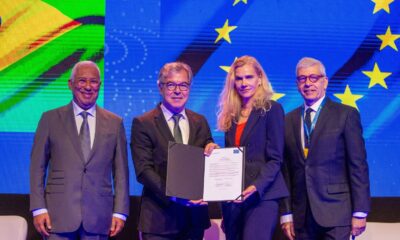Travel
Billionaires, frequent flyers, oil and gas: Who could fund COP29’s $1tn finance target?
“It makes common sense to tax mega polluters and the mega-rich to ensure that we have the money needed for climate action at home and globally” according to one campaigner.
Who should foot the climate finance bill – from loss and damage funds to new funding targets – has become an enduring controversy at recent COPs.
Experts have said that at least $1 trillion (€948 billion) needs to flow to developing nations by 2030 and a new climate finance goal known as the new collective quantified goal (NCQG) hangs in the balance in Baku.
Rich countries are calling for the pool of contributors to be widened. As developing nations deal with the growing frequency and scale of climate disasters, the urgency for these funds increases.
There are big gaps that rich nations will need to fill with innovative forms of finance. From levies on high carbon activities to wealth taxes, what are some of the alternative ideas on the table for raising this cash?
Simple solutions or difficult diplomacy?
A study published by civil society group Oil Change International in September found that rich countries could raise five times the money developing nations are demanding in climate finance with a series of what it calls “simple measures”.
According to the study, a combination of wealth and corporate taxes, taxes on fossil fuel extraction and a crackdown on subsidies could generate $5 trillion (€4.7 trillion) a year – five times what developing nations say they need.
Stopping fossil fuel subsidies alone could free up $270 billion (€256 billion) in rich countries and a tax on fossil fuel extraction could raise $160 billion (€152billion). A frequent flyer levy could total $81 billion (€77 billion) a year from the rich world and increasing wealth taxes on multimillionaires and billionaires would raise a staggering $2.56 trillion (€2.43 trillion). In total, the list of measures it proposes would raise $5.3 trillion (€5.02 trillion) a year.
Some of these options are likely to be easier to implement than others. While adding a levy for frequent fliers doesn’t seem that controversial, money talks and strong opposition from billionaires could stop a wealth tax in its tracks.
Another proposal, redistributing 20 per cent of public military spending to raise $260 billion (€246 billion), could also prove tricky in a world of growing geopolitical instability.
Could a billionaire tax help pay the climate finance bill?
In July, a meeting of G20 finance ministers in Rio agreed to a “dialogue on fair and progressive taxation, including of ultra-high-net-worth individuals”. Brazilian President Luiz Inacio Lula da Silva is hoping to progress talks on this potential billionaire tax at the G20 meeting this week.
The baseline proposal from the finance ministers of Brazil, Germany, Spain and South Africa earlier this year recommended a 2 per cent tax on roughly 3,000 individuals with a net worth of more than $1 billion (€946 million). This would raise around €230 billion a year to fight poverty, inequality – and the climate crisis.
It has broad public support in G20 nations with an Ipsos poll from June showing that 70 per cent of people back the idea that wealthy people should pay higher income tax rates. But as G20 leaders meet in Brazil this week, there are reports that negotiators from Argentina’s new right-wing government are trying to undo progress made on this agreement.
“There is huge popular support in the G20 countries for a tax on the super-rich and it is important that the European countries in the G20 rally behind the Brazillian President to protect the unprecedented agreement on taxing extreme wealth achieved by the finance ministers in July,” says Kate Blagojevic, associate director of Europe campaigns at 350.org.
“It makes common sense to tax mega polluters and the mega-rich to ensure that we have the money needed for climate action at home and globally, which can prevent and repair damage from extreme weather like we have seen in Spain and in Central America over the last few weeks.”
Other countries have not been keen to criticise the proposal in public but many fear that announcing such a tax would cause these ultra-wealthy individuals to flee to nations with more attractive tax policies.
Spain’s economy minister Carlos Cuerpo urged countries on Monday before the G20 meeting to “be brave” and “do things that you are convinced are right”.
Could taxing big oil help pay the climate finance bill?
A small tax on just seven of the world’s biggest oil and gas companies would grow the UN’s Loss and Damage fund by more than 2,000 per cent, according to a new analysis published today by Greenpeace International and Stamp Out Poverty.
It says that introducing what it calls a Climate Damages Tax across OECD countries could play an essential role in financing climate action. This is described as a fossil fuel extraction charge applied to the carbon dioxide equivalent emissions of each tonne of coal, barrel of oil or cubic metre of gas produced.
A tax starting at $5 (€4.74) – and increasing year-on-year – per tonne of carbon emissions based on the volumes of oil and gas extracted by each company would raise an estimated $900 billion (€853 billion) by 2030, it finds. The two groups say this money would support governments and communities around the world as they face growing climate impacts.
“Who should pay? This is fundamentally an issue of climate justice and it is time to shift the financial burden for the climate crisis from its victims to the polluters behind it,” says Abdoulaye Diallo, co-head of Greenpeace International’s Stop Drilling Start Paying campaign.
Diallo adds that the analysis lays bare the scale of the challenge posed by the requirement for loss and damage funding “and the urgent need for innovative solutions to raise the funds to meet it”.
Could taxing frequent fliers help Europe raise climate finance funds?
In Europe, a tax on frequent fliers could raise €64 billion and slash emissions by a fifth, according to a report from environmental campaign groups Stay Grounded and the New Economics Foundation (NEF) published in October.
Currently, regardless of how many times a year you fly, you pay the same amount of aviation tax. But the report proposes an increasing level of tax for each flight a person takes in a year.
It would be added to all trips departing from the European Economic Area (EEA) and the UK, excluding the first two journeys. There would also be a surcharge on the most polluting medium and long-haul flights as well as business and first-class seats.
For the first and second flights taken in a year, a €50 surcharge would be applied to medium-haul and €100 to long-haul, business and first-class flights. For the third and fourth flights, a €50 levy would be added to every ticket plus an additional €50 surcharge for medium-haul and €100 for longer distances and comfort classes.
For fifth and sixth flights, the levy would rise to €100 per flight, plus the additional surcharges. For seventh and eighth flights the levy would be €200, rising to €400 for every flight thereafter.
In a way, this is also a kind of wealth tax. Five per cent of households earning over €100,000 take three or more return flights a year versus just 5 per cent of households earning less than €20,000.
A portion of these funds, according to senior researcher at NEF Sebastian Mang, should be ringfenced for the EU’s contribution to lower and middle-income countries dealing with the sharp end of the climate crisis.
Travel
Norway to introduce tourist tax amid record visitor numbers and overtourism concerns
By Euronews Travel
Published on
ADVERTISEMENT
Norway is set to become the latest European destination to introduce a tourist tax to combat concerns about rising visitor numbers.
Lawmakers approved the new levy on Thursday, which allows municipalities to introduce a 3 per cent tax on overnight stays in “areas particularly affected by tourism”.
The law allows local authorities to apply the tax at their own discretion, and it will be added to accommodation charges. Authorities will also be allowed to adjust the percentage based on the season.
The funds raised by the tax will be used exclusively to improve tourism infrastructure projects that benefit both visitors and local people. Municipalities will have to demonstrate that their facilities are inadequate and have their plans approved by the government to spend the funds.
Cecilie Myrseth, Norway’s minister of trade and industry, said on social media that her government had reached a “historic agreement” to introduce a tourism tax that was “in line with what they have in the rest of Europe”.
The country is the latest in a string of European nations introducing or increasing visitor levies to tackle the growing problem of overtourism. A tax may also be applied to cruise ships that make stops in the country, particularly in areas that are most affected by overtourism.
Norway is experiencing a tourism boom
As tourists increasingly choose cooler, northern European destinations to get away from the heat, Norway has experienced a boom in visitor numbers.
Last year, a record-breaking 38.6 million people booked accommodation in the country. That includes more than 12 million overnight stays by foreign tourists – a 4.2 per cent increase from 2023.
Some previously quiet destinations have been overwhelmed, like the Lofoten islands, where eye-catching images of hiking trails posted on social media have led to an influx of visitors. With a population of 24,500 people distributed across several small towns and villages, keeping up with the cost of all these new visitors has been hard.
A recent survey by industry organisation Norwegian Tourism Partners found that 77 per cent of people in Tromsø, in northern Norway above the Arctic Circle, thought there were too many tourists there. Visitors have been drawn by the Northern Lights, wildlife excursions, Sami cultural experiences and what the city itself has to offer.
The increase in tourism has caused tension with local residents across Norway as infrastructure has struggled to keep up with the boom. Facilities like public toilets and car parks have been overwhelmed in popular destinations.
Some residents have even reported cases of people using their back gardens as toilets, and bemoaned the increased traffic clogging up Norway’s roads.
Travel
Wildfire warnings issued in the Canary Islands as millions prepare to holiday there
ADVERTISEMENT
As millions of holidaymakers prepare to head to the Canary Islands this summer, authorities have issued a wildfire pre-alert across the archipelago.
The warning, announced by the General Directorate of Emergencies on Sunday, applies to tourist hotspots El Hierro, La Palma, La Gomera, Tenerife and Gran Canaria.
It comes as the islands enter a high-risk fire period following the wet season, as hot, dry winds known as the ‘calima’ begin blowing in from the Sahara Desert.
Fires are common, but they haven’t slowed tourism
The risk of wildfire is nothing new for the Canary Islands.
The volcanic terrain, Mediterranean climate and fire-adapted vegetation – plants that have evolved to thrive in fire-prone environments – make them susceptible to summer blazes, and scientists say wildfires are part of the archipelago’s ecological rhythm.
Some of the worst occurred in 2023, when forest fires ravaged Tenerife, destroying more than 15,000 hectares of land and forcing 12,000 people to evacuate. The blaze was later found to have been started by arsonists.
This year, officials are urging tourists and locals alike to take extreme caution, warning against launching fireworks near forests and discarding cigarettes on dry ground.
But even as the fire warnings roll in, the Canaries’ appeal shows no signs of slowing down.
In 2024, the islands welcomed nearly 18 million tourists, including a record-breaking 15.5 million international arrivals. Among them, British travellers led the way, recording 6.3 million visits – up 500,000 from 2023.
Concerns about overtourism mount amid record arrivals
While the Canary Islands continue to attract record numbers of tourists, residents are increasingly voicing concerns about overtourism.
In April 2024, tens of thousands of islanders participated in protests, holding signs that read “the Canary Islands have a limit” while rallying against rising housing costs, environmental damage and the strain on public services.
Over Easter this year, about 80,000 hospitality workers in Tenerife, La Palma, La Gomera and El Hierrowalked out in a dispute with unions over pay.
The surge in short-term rentals has been especially contentious. Locals have reported getting priced out of their neighbourhoods as properties are converted into holiday lets, the cost of living soars and wages stagnate.
Despite these concerns, tourism remains a significant part of the Canary Islands’ economy, accounting for approximately 35 per cent of its GDP.
Tenerife still reigns supreme
After welcoming seven million tourists in 2024, Tenerife remains the most visited island.
Its year-round sunshine and wide beaches keep it a firm favourite among families, especially during the UK’s summer school break and throughout the winter months.
As the peak summer season picks up, local tourism boards have made no indication that the fire pre-alerts will disrupt travel plans.
But authorities remain focused on prevention this year.
More than 2,000 firefighters are on standby. Meanwhile, the government has distributed detailed safety advice, urging people to prepare a go-bag, stay informed and follow emergency evacuation or shelter-in-place instructions if fires erupt.
Travel
Violent turbulence hits Ryanair flight in Germany, forcing an emergency landing and injuring 9
By Euronews Travel with AP
Published on
ADVERTISEMENT
Severe storms in southern Germany forced a Ryanair flight to make an emergency landing late Wednesday after violent turbulence injured nine people on board, German police said in a statement Thursday.
The flight, travelling from Berlin to Milan with 179 passengers and six crew members, encountered turbulence so intense around 8:30 pm that the pilot was forced to make an unscheduled landing at Memmingen Airport in Bavaria.
Eight passengers and one crew member were hurt.
Three people were taken to the hospital in Memmingen for treatment; the other injured people were released after receiving outpatient treatment. As a precaution, all passengers were checked for injuries by the emergency services.
Authorities did not permit the plane to continue flying, and the airline arranged bus transport for passengers. Milan is about 380 kilometres south of Memmingen.
More bad weather expected in Germany
Elsewhere in the region, storms damaged several homes in Ulm, Baden-Württmberg, according to the German news agency dpa.
In the Donaustetten district, strong winds tore roofs off multiple row houses, rendering them uninhabitable, though no injuries were reported. Fire officials suspect a small tornado or waterspout caused the damage. The German Weather Service (DWD) is investigating, according to dpa.
Storm-related emergency calls also came from other areas in southern Germany, where damage was mostly limited to fallen trees and flooded basements.
The DWD warned of further storms on Thursday, 5 June, with hail, strong winds, and localised heavy rain expected.
-
EU & the World6 days ago
Aurora Borealis Forecast: Where & When to See the Northern Lights Tonight
-

 EU & the World7 days ago
EU & the World7 days agoRihanna’s Parents: About Her Late Dad Ronald Fenty & Mom Monica Braithwaite
-

 Sports6 days ago
Sports6 days agoOfficial: Damien Comolli new general manager of Juventus.
-

 EU & the World7 days ago
EU & the World7 days agoLoretta Swit’s Net Worth: How Much Money the ‘M*A*S*H’ Alum Had
-

 EU & the World7 days ago
EU & the World7 days agoTaylor Swift’s Net Worth: How Much Money She Has in 2025
-

 Politics7 days ago
Politics7 days agoEurope and Brazil Forge a New Economic Alliance: A Strategic Bet on Stability, Sustainability, and Shared Values
-

 EU & the World7 days ago
EU & the World7 days ago‘King of the Hill’ Revival: Upcoming Hulu Sitcom’s Release Date & More
-

 Sports5 days ago
Sports5 days agoManuel Locatelli forced to leave Italy's training camp









